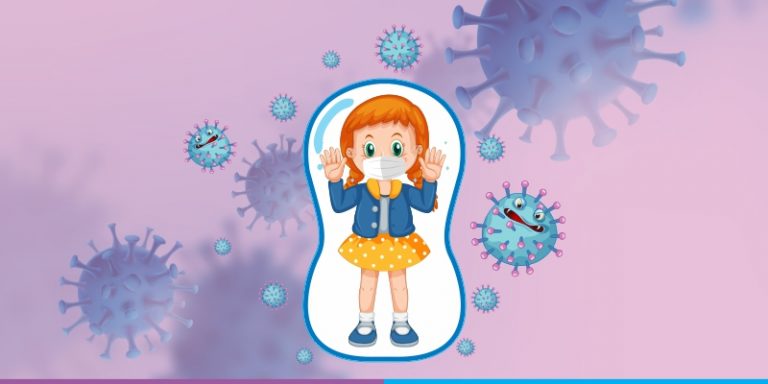
Know more about Child care & COVID-19
COVID-19 stands for “coronavirus disease 2019.” It is caused by a virus called SARS-CoV-2. The virus first appeared in late 2019 and quickly spread around the world. People with COVID-19 can have fever, cough, trouble breathing and other symptoms. Problems with breathing happen when the infection affects the lungs and causes pneumonia. Most people who get COVID-19 will not get severely ill. But some do. In many areas, people have been told to stay at home and away from other people. This is to slow down the spread of the virus.
The virus mainly spreads from person to person and it usually happens when an infected person coughs, sneezes, or talks near other people. The virus is passed through tiny droplets from the infected person’s lungs and airway. These droplets travel through the air and get transmitted to other people who are nearby. It also spreads at gatherings when people are talking close together, shaking hands, hugging, sharing food. Eating at restaurants also raises the risk of infection since people tend to be close to each other and not covering their faces. It is also possible to get infected when you touch a surface that has the virus on it and then touch your mouth, nose, or eyes. Know more about Child care & COVID-19
Some important questions on COVID-19 & Child Care
Can children get infected with COVID-19?
Yes, children of any age can get infected with COVID-19. They are less likely to get seriously ill, but it can still happen. It is possible for children to spread the virus to other people and can be dangerous for older people or who have other health problems.
Are COVID-19 symptoms different in children than adults?
Not really. In adults, common symptoms include fever and cough. In some other cases, people can develop pneumonia and have trouble in breathing. Children infected with COVID-19 can have these symptoms too but are less likely to get very sick, but some children do not have any symptoms at all. Other symptoms might include feeling very tired, shaking chills, headache, muscle aches, sore throat, a runny or stuffy nose, diarrhoea, or vomiting. Babies infected with COVID-19 might have trouble in feeding. There have been some reports of rashes or other skin symptoms. For example, some people with COVID-19 get reddish-purple spots on their fingers or toes. But it’s not clear why or how often this happens.
There have been reports of children with COVID-19 developing inflammation throughout the body. This can lead to organ damage if it is not treated quickly. Experts have used different names for this condition, including “multisystem inflammatory syndrome in children”(MISC ) and “paediatric multisystem inflammatory syndrome.” The symptoms can appear similar to another condition called “Kawasaki disease.” They include:
- Fever that lasts longer than 24 hours
- Belly pain, vomiting or diarrhoea
- Rash
- Bloodshot eyes
- Headache
- Being extra tired or acting confused or irritable
- Trouble in breathing
How can you prevent your child from getting infected with COVID-19?
Experts are working on vaccines to prevent COVID-19. When a vaccine becomes widely available and when a lot of people get it, the virus will stop spreading so quickly. While we wait for a vaccine, there are other things people can do to reduce their chances of getting COVID-19. These things will also help slow the spread of infection.
- Practice social distancing. It means keeping people, away from each other. It is also sometimes called physical distancing.
- Wear a cloth mask in public. It is recommended for everyone, including children 2 years and older. This is mostly, if your child is sick, even if they don’t have any symptoms, they are less likely to spread the infection to other people. It might also help protect your child from others who could be sick.
- Wash their hands with soap and water often. Make sure to rub the hands with soap for at least 20 seconds. Washing with soap and water is best. They can also use a hand sanitizing gel to clean their hands. The gels with at least 60% alcohol work the best. It’s important to keep sanitizer out of reach from children since the alcohol can be harmful if swallowed. If your child is younger than 6 years old, help them when they use sanitizer.
- Younger children might need help or reminders to avoid touching face with their hands, especially their mouth, nose, or eyes.
What if someone at your home is sick?
If someone at your home is infected with COVID-19, they should stay in a separate room and should also wear a face mask. Everyone in the house should wash their hands often and clean the surfaces that are frequently touched. If you are sick and you have a baby, it’s important to be extra careful when breastfeeding or holding them. Till now it’s not known whether the virus can be spread through breast milk or not. You can protect your baby by washing your hands often and wear a face mask while you feed them.
How can you help the child to cope with stress and anxiety?
It is normal to feel anxious or worried about COVID-19. It’s also normal to feel lonely when you can’t do your normal activities or see friends and relatives. And it can be hard to manage work and child care when your family has to stay at home.
You can help your child by:
- Talking to them simply about COVID-19 and why “social distancing” is important
- Encouraging them to practice wearing a mask
- Limiting what they see on the news or internet
- Finding activities you can do together
- Helping them keep in touch with friends and relatives through video calls
- Taking care of yourself, including eating healthy foods and getting regular exercise

Dr K V Raja Ramesh
MBBS, DCH, DNB
Consultant Paediatrician
Giggles by OMNI RK, Visakhapatnam